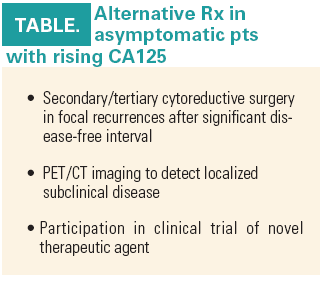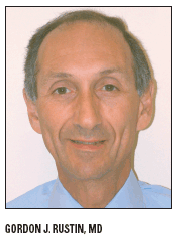Less is more when it comes to serial CA125 testing in ovarian cancer
ORLANDO-For the majority of women who undergo ovarian cancer treatment, disease relapse is a matter of when rather than if. These women could spend the rest of their lives undergoing regular CA125 serum marker testing. A recent study that compares the quality of life in early- and advanced-stage ovarian cancer survivors found that CA125 marker measurements for recurrence were, understandably, a source of anxiety for both groups.
ABSTRACT: Oncologists need to reconsider how to use a long-standing test, according to trial results that indicated no survival benefit for early detection of ovarian cancer recurrence.
ORLANDO-For the majority of women who undergo ovarian cancer treatment, disease relapse is a matter of when rather than if. These women could spend the rest of their lives undergoing regular CA125 serum marker testing. A recent study that compares the quality of life in early- and advanced-stage ovarian cancer survivors found that CA125 marker measurements for recurrence were, understandably, a source of anxiety for both groups.

Will the results of a European trial showing that detecting recurrence early did not lead to better overall survival free women from the clutches of CA125 testing? Gordon J. Rustin, MD, who presented the study results at ASCO 2009, certainly thinks so.
“For the first time, women can be reassured that there is no benefit to early detection of recurrence with routine CA125,” Dr. Rustin said during an ASCO press conference. “Even if the CA125 rises, chemotherapy can be safely delayed until they have signs and symptoms of recurrence. Women now have informed choices to be able to decide.”
Of course, the offer of that reassurance falls on the shoulders of physicians. “This is not going to result in a 180° change in behavior in the U.S. This is something that medical oncologists and gynecologic oncologists need to talk about,” said ASCO press conference moderator Eric Winer, MD, director, Breast Oncology Center, and chief, division of women’s cancers at Boston’s Dana-Farber Cancer Institute.

‘Far more chemo in their lifetimes’
For the MRC OV05/EORTEC 55955 trial, Dr. Rustin and colleagues enrolled 1,400 ovarian cancer patients who were in clinical complete remission after first-line platinum-based chemotherapy and showed a normal CA125. CA125 was measured every three months; patients and physicians were blinded to the results.
“If CA125 levels rose to more than twice the upper limit of normal, patients were randomized either to an early-treatment arm or a delayed-treatment arm, where they continued having blood tests every three months and started Rx only when they started showing signs and symptoms of relapse,” said Dr. Rustin, who is based at Mount Vernon Cancer Centre at Mount Vernon Hospital in London. His co-lead investigator was Maria van der Burg, MD, from Erasmus Medical Center and Daniel den Hoed Cancer Center in Rotterdam, the Netherlands.
Patients did not undergo CT scan confirmation of complete clinical remission, he explained. The primary outcome was overall survival. Additional endpoints were time to second-line treatment and time to third-line treatment or death. Quality of life assessments were also measured.
The investigators found that patients in the early-treatment arm started their second-line chemotherapy, based on the rising CA125, 4.8 months earlier than those who waited until they had signs and symptoms. “Although many of these women go on to have third- or fourth-line chemotherapy, the time to third-line chemotherapy was 4.6 months earlier in the early (treatment) group, indicating that early institution of chemotherapy did not induce a longer remission,” Dr. Rustin said.
The researchers concluded that early treatment based on rising CA125 did not improve survival and may have even decreased quality of life. “Women in the early arm got far more chemo in their lifetimes,” he said. Dr. Rustin told Oncology News International that he hopes to see the trial results published by the end of 2009.
What to tell patients?
In Dr. Winer’s estimation, gynecologic oncologists should take a cue from their breast cancer counterparts. “This puts ovarian cancer on the same playing field as breast cancer. When a woman is treated for breast cancer, we follow to detect the second primary. We’ve learned from randomized studies that there is no value in obtaining extensive diagnostic tests after treatment. This is always a long conversation with patients.”
Dr. Rustin said that he discourages patients in his practice from serial CA125 testing. “Most of my patients, when I give them the information, they say, ‘I do not want routine serial CA125 measurements.’ But I do tell them to look for likely signs of relapse. We offer rapid access to CA125 and blood tests to get them back on chemotherapy.”
David Alberts, MD, director of the Arizona Cancer Center and an ovarian cancer specialist, agreed that climbing CA125 need not be a red flag. “Women need to know that a rising serum CA125 is an excellent biomarker of recurrent ovarian cancer, but there is no immediate urgency to start treatment if there is no symptomatology...(CA125) is not an absolute guide to the exact time point for restarting chemotherapy for recurrent disease.”

For Dr. Alberts, the CA125 test isn’t the problem; it’s the oncology community’s failure to offer better therapy. “Our treatment armamentarium for recurrent disease is relatively poor. We need more effective drugs,” Dr. Alberts told Oncology News International.
Kristina Mirabeau-Beale and colleagues at Boston’s Harvard Medical School and the Dana-Farber Cancer Institute interviewed early- and advanced-stage ovarian cancer survivors about their long-term adjustment and quality of life (Gynecol Oncol online, May 27, 2009).
“Our study did show that, irrespective of staging, many ovarian cancer survivors experienced fear of recurrence and anxiety about CA125 testing,” Ms. Mirabeau-Beale told Oncology News International. “As such, this finding, that by delaying CA125 testing we are not sacrificing survival, could alleviate some anxiety in patients, though this is dependent on both patients and clinicians being comfortable not serially measuring CA125.”

Ms. Mirabeau-Beale is a fourth-year medical student at Harvard. The primary investigator on the study was Ursula Matulonis, MD, director of medical gynecologic oncology at the Dana-Farber Cancer Institute in Boston and assistant professor of medicine at Harvard Medical School. Managing a patient’s expectation is key, she said. If a patient is determined to undergo routine testing, then no amount of scientific evidence will assuage her anxiety. But offering a woman more autonomy in her treatment planning could have a positive effect on her quality of life. “The trial affirms a core value: As clinicians, we should treat the whole patient and not an isolated or specific lab value,” she said.
Dr. Rustin agreed: “If you ask most women, they would say that life off chemo is nicer than life on chemo. If you can delay chemo with no disadvantage, you’ve done that woman a huge service.”
REBUTTAL FROM DR. RUSTIN
The Ovarian Cancer National Alliance and the Society of Gynecologic Oncologists released official statements on the data. Dr. Rustin shared his response to those comments with Oncology News International. Ovarian Cancer National Alliance: CA125 was developed by Dr. Robert Bast, vice president for translational research at M.D. Anderson Cancer Center in Houston. Dr. Bast commented that the data may be misinterpreted, as physicians who participated in the study were not required to use one therapeutic protocol but made their own determination on which chemotherapy to use. Dr. Bast explained, “The majority of women did not receive optimal chemotherapy at the time of disease recurrence.”

Dr. Rustin: Dr. Bast is mistaken in stating that the majority of women did not receive optimal chemotherapy at the time of recurrence. Patients in the OV05/55955 trial were all offered the best available therapy at the time of relapse. As the trial was open from 1995 to 2008, there were changes in available therapies so it was left to the treating physicians to decide on the best therapy available at that time, rather than mandate a set protocol or treatment regimen that would become out of date.
Society of Gynecologic Oncologists: The trial did not address the role of secondary cytoreduction in recurrent cases, participants were not stratified for residual disease after cytoreduction, remission was not consistently confirmed by imaging, and treatment regimens at relapse were not standardized.
Dr. Rustin: Secondary cytoreduction, which has not been shown in any randomized trial to improve survival, was an option available to all patients and was performed in some patients. The main endpoint of the trial was overall survival, and even when adjusted for stratification and prognostic factors, there was still no significant difference between the two arms.
Q & A WITH DR. KARLAN
Q: What might the legal implications be for discontinuing serial CA125 testing?
Dr. Karlan: The new data may be protective for physicians when there is a question in delay of diagnosis of recurrence. This is a matter of communication. My own approach has been to have a frank and honest discussion with my patients, recognizing that physicians, no matter how much experience we have, can’t predict the future. These data are a call to arms for us to refocus our efforts to find better methods for early detection and more targeted, personalized therapies.
Q: What about the economic implications?
Dr. Karlan: We are facing a healthcare crisis in this country. Based on current estimates, we are expected to run up a $15 billion deficit in the next 15 years if we don’t reduce our spending. Can we continue to commit resources to intensive CA125 surveillance without demonstrating an objective survival benefit or effect on quality of life?
Q: Should CA125 monitoring become obsolete?
Dr. Karlan: I don’t think we should go that far. I don’t believe we should continue monitoring quarterly after normalization and completion of primary therapy in asymptomatic women who are not enrolled in a clinical trial. But we also need to consider what patients will accept. Many women often say they live from one CA125 test to the other. It took 10 years for this trial to meet its recruitment goal. Perhaps this is a reflection of women’s unwillingness to be blinded to their CA125 results.